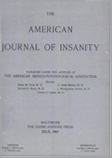CHEMICAL ANALYSES OF TWO PATHOLOGICAL HUMAN BRAINS
Abstract
The principal changes in the cerebrum of the case of paresis ("Path. K.") were in the lipins and extractives. The substances (cerebrosides) associated most closely with sheath development showed largest losses. The phosphatids and sulphatids are present in smaller amounts than in normal cerebra. Both organic and inorganic extractives show maked increases in percentage and absolute amounts. This is to be expected in degenerative changes, if it is the more complex structure substances that alter to simpler compounds which are but partly removed from the tissue.
The changes in the cerebrum in the case of organic brain disease ("Path. A.") (probably bulbar paralysis) which gave a syphilitic history show essentially the same kind of change as the case above; but all were less marked. This would suggest that the alterations were due to the action of spirochætes. The midbrain, medulla, and pons exhibited about the same kind of chemical changes as the cerebrum. The cerebrosides, sulphatids and phosphatids, and therefore total lipins, showed distinct losses. The proteins, water and total solids were nearly normal; but both organic and inorganic extractives were high. Though the data for the cerebellum show variations, they are not supposed to be of pathological significance.
Access content
To read the fulltext, please use one of the options below to sign in or purchase access.- Personal login
- Institutional Login
- Sign in via OpenAthens
- Register for access
-
Please login/register if you wish to pair your device and check access availability.
Not a subscriber?
PsychiatryOnline subscription options offer access to the DSM-5 library, books, journals, CME, and patient resources. This all-in-one virtual library provides psychiatrists and mental health professionals with key resources for diagnosis, treatment, research, and professional development.
Need more help? PsychiatryOnline Customer Service may be reached by emailing [email protected] or by calling 800-368-5777 (in the U.S.) or 703-907-7322 (outside the U.S.).



